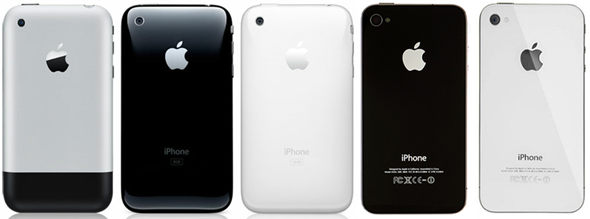It was in January 2007 when Steve Jobs, on stage at Macworld, proudly announced the original iPhone. It was, according to Jobs, a revolutionary three-in-one product: a widescreen iPod with touch controls, a revolutionary mobile phone and a breakthrough Internet communications device. It was released on June 29th the same year for $599 with a contract on AT&T. Now, if you notice the release date, that’s exactly five years from today.
In this post, we will be discussing the iPhone’s significance and sharing a lovely infographic. Check it all out after the jump.
The iPhone has had a phenomenal effect on the mobile industry. User-interfaces* are much more touch-oriented, quality and quantity of third-party apps – which is one of the iPhone’s strongest points – are considered super-important and wireless carriers now play a less-dominant role in design and marketing of phones. Today, companies like RIM and Nokia who didn’t skate to where the puck is going** (or even where it is right now) face heavy losses and decreasing market share. All because of one series of smartphones: the iPhone.
The original iPhone (2007) had its fair share of limitations – lack of multitasking, 3G support, third-party apps, cut-copy-paste, a good camera – that were remedied in successive iterations of the iPhone and its iOS operating system. The latest iPhone – iPhone 4S – is universally acclaimed for its outstanding camera, smooth performance, great battery life and the powerful iOS operating system that runs it.
The iPhone is not just a critical success too, commercially it is proved to be a game changer for Apple. Along with the iPad, the iPhone accounts for a majority of Apple’s revenue. It has taken Apple’s stock from $122 in mid-2007 to $578 today and made it the most valuable company in the world. Apple so far has sold a whopping 250 million iPhones, more than any sales of any one series of smartphones. More information regarding the iPhone’s effect on Apple as a company can be understood from this lovely infographic created by Statista:
Having played around with different mobile platforms for extensive periods of time, I can confidently say that the iPhone is the best smartphone money can buy today. I’m a proud owner of the iPhone 4S, as is just about everyone working here at Redmond Pie. I’m sure quite a few of our readers are iPhone fans as well, so be sure to leave a comment regarding your thoughts on the iPhone and its effect on you and the rest of the mobile industry over on our Facebook and Google+ page when you’re done reading.
Yep, today is the birthday of the smartest and most special 5-year-old.
Steve Jobs’ original iPhone keynote at Macworld 2007 is unanimously considered as his best ever. The man was in a mood that day, slowly but surely building up hype throughout the keynote, making his points for a revolutionary smartphone that would actually be smart while being easy to use, demoing the phone’s best aspects and just being the badass that he was. No other keynote shows the effects of his reality-distortion field (RDF) such as this. Jobs’ presentation skills are so good, as a matter of fact, that just for a second, I actually considered getting myself an original iPhone.
*When Steve Jobs claimed that the iPhone’s UI was five years ahead of the competition, he wasn’t wrong. It took Android exactly five years (Project Butter in 4.1 Jelly Bean) to come even close to the iPhone / iOS’s level of UI smoothness, ease-of-use and consistency.
** I am, of course, referring to a Steve Jobs quote: “There’s an old Wayne Gretzky quote that I love. ‘I skate to where the puck is going to be, not where it has been.’ And we’ve always tried to do that at Apple. Since the very very beginning. And we always will.”
You can follow us on Twitter, add us to your circle on Google+ or like our Facebook page to keep yourself updated on all the latest from Microsoft, Google, Apple and the web.

